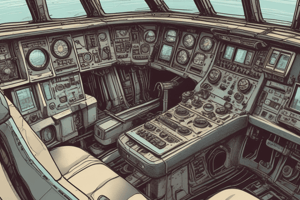Podcast
Questions and Answers
What is the primary purpose of the On-Board Maintenance System (OMS)?
What is the primary purpose of the On-Board Maintenance System (OMS)?
- To control aircraft systems during flight
- To monitor aircraft performance during flight
- To assist maintenance personnel in fault-finding of complex avionics systems (correct)
- To provide real-time weather updates to pilots
What benefit does the On-Board Maintenance System (OMS) provide in terms of maintenance processes?
What benefit does the On-Board Maintenance System (OMS) provide in terms of maintenance processes?
- Increases the efficiency of maintenance processes (correct)
- Has no impact on maintenance processes
- Decreases the efficiency of maintenance processes
- Only supports line maintenance
What is the function of the Central Maintenance System (CMS) in the On-Board Maintenance System (OMS)?
What is the function of the Central Maintenance System (CMS) in the On-Board Maintenance System (OMS)?
- To control aircraft navigation systems
- To enable the mechanic to extract maintenance data and initialise tests on aircraft systems (correct)
- To monitor engine performance during flight
- To provide real-time aircraft performance data
What are the main components of the Central Maintenance System (CMS)?
What are the main components of the Central Maintenance System (CMS)?
What is the result of using the On-Board Maintenance System (OMS)?
What is the result of using the On-Board Maintenance System (OMS)?
What is one of the functions supported by the On-Board Maintenance System (OMS)?
What is one of the functions supported by the On-Board Maintenance System (OMS)?
What is an example of a Class 2 failure?
What is an example of a Class 2 failure?
Where are the systems affected by Class 2 failures identified?
Where are the systems affected by Class 2 failures identified?
What is a characteristic of Type 1 system computers?
What is a characteristic of Type 1 system computers?
What is the purpose of a discrete input on Type 2 systems?
What is the purpose of a discrete input on Type 2 systems?
How many flights can Type 1 system computers memorise failures for?
How many flights can Type 1 system computers memorise failures for?
What is the output connection of Type 2 systems?
What is the output connection of Type 2 systems?
What is the primary function of electronic devices used on flight decks?
What is the primary function of electronic devices used on flight decks?
Where are electronic display units usually installed on flight decks?
Where are electronic display units usually installed on flight decks?
What is a characteristic of Class 1 EFB systems?
What is a characteristic of Class 1 EFB systems?
What is a requirement for using Class 2 EFB systems in an aircraft?
What is a requirement for using Class 2 EFB systems in an aircraft?
What document contains descriptions of EFB classes of hardware?
What document contains descriptions of EFB classes of hardware?
What is another term for Class 1 EFB systems?
What is another term for Class 1 EFB systems?
What does the CMC do at each leg opening transition?
What does the CMC do at each leg opening transition?
What is the primary function of the CMC in a commercial aircraft?
What is the primary function of the CMC in a commercial aircraft?
What is the primary function of the Aircraft Communication Addressing and Reporting System (ACARS)?
What is the primary function of the Aircraft Communication Addressing and Reporting System (ACARS)?
What is the purpose of a data loader in an aircraft?
What is the purpose of a data loader in an aircraft?
What happens when the CMC 1 experiences a BITE fault?
What happens when the CMC 1 experiences a BITE fault?
How can the CMC be switched in a commercial aircraft?
How can the CMC be switched in a commercial aircraft?
What is the benefit of integrating the CMC with ACARS and other communication systems?
What is the benefit of integrating the CMC with ACARS and other communication systems?
What is the purpose of the two CMCs in a large modern commercial aircraft?
What is the purpose of the two CMCs in a large modern commercial aircraft?
What type of data can be downloaded from the aircraft using a data loader?
What type of data can be downloaded from the aircraft using a data loader?
What is the typical connection point for a data loader?
What is the typical connection point for a data loader?
What happens when the off legend illuminates on the pushbutton switch?
What happens when the off legend illuminates on the pushbutton switch?
What is a characteristic of a data loader?
What is a characteristic of a data loader?
Flashcards are hidden until you start studying
Study Notes
On-Board Maintenance System (OMS) Overview
- OMS aids maintenance personnel in diagnosing complex avionics systems through integrated techniques.
- Supports various activities: aircraft maintenance (scheduled and unscheduled), engineering follow-up, and aircraft reconfiguration.
- Goals include minimizing ground time, enhancing maintenance efficiency, and improving cost-effectiveness.
Components of OMS
- Central Maintenance System (CMS): Extracts maintenance data and initiates tests across aircraft systems.
- Data Loading System: Allows the loading and updating of software in avionics systems.
- Electronic Library System: Provides access to necessary technical documentation.
- Report Printing System: Facilitates the generation of maintenance reports.
Central Maintenance System (CMS)
- Consists of Central Maintenance Computers (CMC 1 and CMC 2) and Multipurpose Control and Display Units (MCDUs).
- CMCs record flight data, including leg transitions (dates, flight numbers, airport pairs).
- Features switching control for redundancy: CMC 1 acts as master under normal operations, with CMC 2 taking over if necessary.
- Anomalies trigger alerts communicated through MCDUs and can report to maintenance bases via ACARS or ATSU.
Aircraft Communications Addressing and Reporting System (ACARS)
- CMC integrates with ACARS and other communication systems to relay maintenance information before arrival at the destination, allowing proactive troubleshooting.
Data Loading System
- Essential for software updates, typically linked with Flight Management Systems (FMS) or data bus couplers.
- Can be portable or integrated, allowing loading of updates or downloading operational data.
Electronic Flight Bag (EFB) Classes
- Class 1 EFB: Portable systems that are not mounted; do not require administrative control prior to use.
- Class 2 EFB: Mounted systems requiring airworthiness approval; can connect with avionics equipment.
- Class 3 EFB: Designed for ground use only, with limited operational or safety implications.
System Computers Types
- Type 1: Connected to CMCs via ARINC 429 bus; stores failures from the last 64 flights for in-depth troubleshooting.
- Type 2: Tracks failures from the last flight only; simpler initialization for testing through discrete input.
Failure Classifications
- Class 2 Failures: Non-operational for current flight with specific systems shown on ECAM status.
- Class 3 Failures: Have no operational or safety implications; accessible solely from ground systems.
Studying That Suits You
Use AI to generate personalized quizzes and flashcards to suit your learning preferences.




